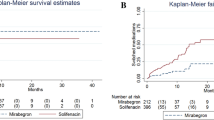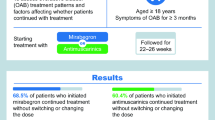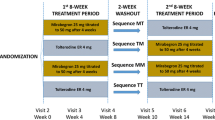Abstract
Introduction and hypothesis
Most published data on mirabegron relates to short-term clinical trials and suggest that it might be effective in controlling OAB and have low side effects. This study aimed to identify persistence with mirabegron, changes in symptoms and quality of life, and predictors of perseverance over 1 year.
Methods
The study was a large, prospective case series of 354 patients who were prescribed mirabegron for OAB between February 2013 and July 2014. At 1 year, patients filled out patient global impression of improvement, the International Consultation on Incontinence female lower urinary tract symptoms questionnaire (ICIQ-FLUTS) and PFDI questionnaires. The reasons for discontinuing treatment were identified.
Results
Outcomes were available for 88 % of the cohort. Twenty five percent continued mirabegron therapy at 1 year with 26 % “very much better” and 37 % “much better”. ICIQ-FLUTS (17.2–13.4; p = 0.002) and urinary distress inventory (UDI) (59.2–44.3; p < 0.001) scores demonstrated significant improvements from baseline (pre-treatment) compared with 1 year. The ICIQ-FLUTS “filling score” increased from 3.55 at 6 weeks to 5.27 at 1 year (p = 0.02) despite continuing mirabegron therapy. The most common causes of discontinuation were lack of efficacy (26 %) and side effects (10 %). Thirty-seven percent of the cohort was taking mirabegron in combination with an anticholinergic. Patients who were treatment naïve were more likely to discontinue mirabegron than those who had previously taken anticholinergics (p = 0.02).
Conclusions
Over two thirds of patients discontinue mirabegron therapy within 1 year. A significant proportion of patients were on combined therapy to control symptoms. The initial improvement in symptom scores seems to deteriorate. The improvements in quality of life are sustained in patients who persist with therapy.

Similar content being viewed by others
References
Khullar V, Chapple C, Gabriel Z, Dooley JA (2006) The effects of antimuscarinics on health-related quality of life in overactive bladder: a systematic review and meta-analysis. Urology 68 [2 Suppl]:38–48
Veenboer PW, Bosch JL (2014) Long-term adherence to antimuscarinic therapy in everyday practice: a systematic review. J Urol 191(4):1003–1008
Maman K, Aballea S, Nazir J et al (2014) Comparative efficacy and safety of medical treatments for the management of overactive bladder; a systematic literature review and mixed treatment comparison. Eur Urol 65:755–765
Duckett JR, Vella M, Kabalakuntia G, Basu M (2007) Tolerability and efficacy of duloxetine in a nontrial situation. BJOG 114(5):543–547
Chapple CR, Kaplan SA, Mitcheson D et al (2014) Mirabegron 50mg once-daily for the treatment of symptoms of overactive bladder: an overview of efficacy and tolerability over 12 weeks and 1 year. Int J Urol 21:960–967
Brostrom S, Hallas J (2009) Persistence of antimuscarinic drug use. Eur J Clin Pharmacol 65:309–314
Linner L, Schioler H, Samuelsson E, Milsom I, Nilsson F (2011) Low persistence rates of anticholinergic drug use in Sweden. Eur J Clin Pharmacol 67:535–536
Balachandran AA, Duckett JR (2015) The risk and severity of developing symptomatic palpitations when prescribed mirabegron for overactive bladder. Eur J Obstet Gynecol Reprod Biol 187:60–63
Abrams P, Kelleher C, Staskin D et al (2015) Combination treatment with mirabegron and solifenacin in patients with overactive bladder: efficacy and safety results from a randomised, double blind, dose-ranging, phase 2 study (Symphony). Eur Urol 67:577–588
Yamaguchi O, Kakizaki H, Homma Y et al (2015) Safety and efficacy of mirabegron as “add-on” therapy in patients with overactive bladder treated with solifenacin; a post-marketing, open label study in Japan (MILAI study). BJU Int 116:612–622
Wagg A, Compion G, Fahey A, Suddiqui E (2012) persistence with prescribed antimuscarinic therapy for overactive bladder: a UK experience. BJU Int 110:1767–1774
Acknowledgements
Astellas has previous provided funding for the initial assessment of this cohort. However, they provided no funding for this long-term follow-up and have not had access to the manuscript or any results contained therein.
Author information
Authors and Affiliations
Corresponding author
Ethics declarations
Conflicts of interest
The initial study of 354 patients was supported by a research grant from Astellas. No support was provided for the 1-year follow-up study. Astellas provided no input into the 1-year study.
J. Duckett: see acknowledgements above. A. Balachandran: none.
Rights and permissions
About this article
Cite this article
Duckett, J., Balachandran, A. Tolerability and persistence in a large, prospective case series of women prescribed mirabegron. Int Urogynecol J 27, 1163–1167 (2016). https://doi.org/10.1007/s00192-016-2945-4
Received:
Accepted:
Published:
Issue Date:
DOI: https://doi.org/10.1007/s00192-016-2945-4




